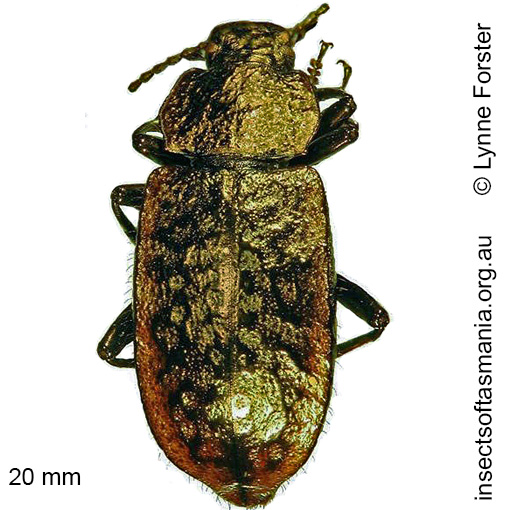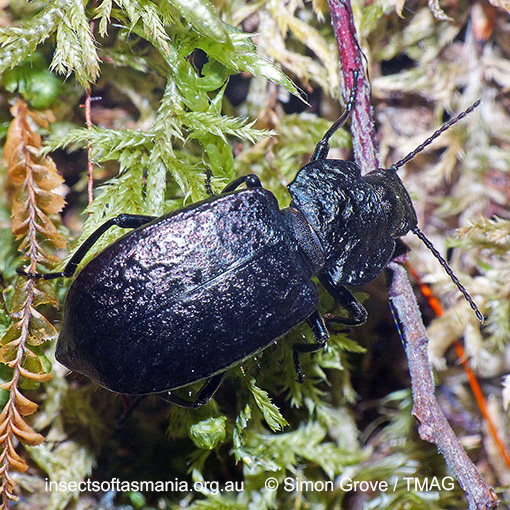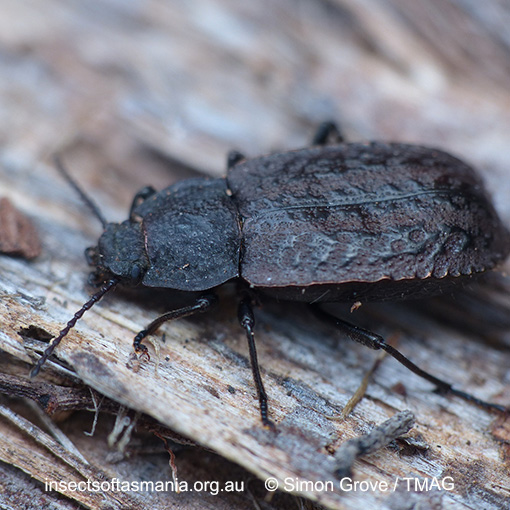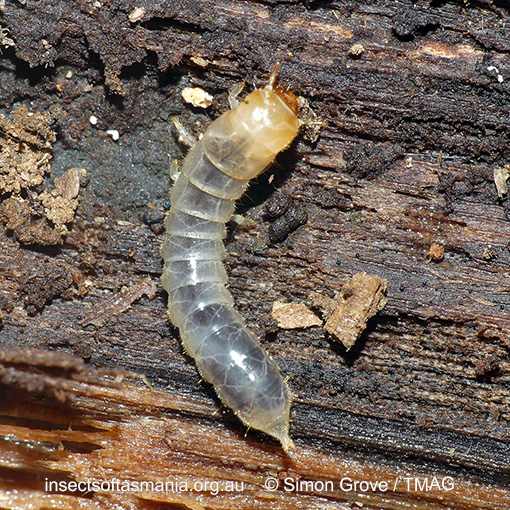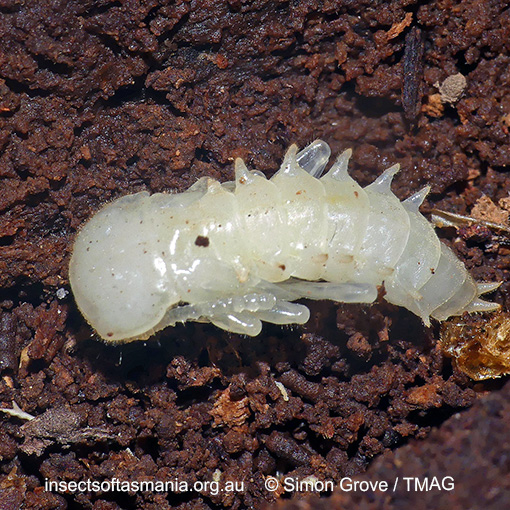
Coripera deplanata (a species of darkling-beetle)
Basis for Tasmanian occurrence
TMAG collections
Classification
Suborder: Polyphaga
Superfamily: Tenebrionoidea
Family: Tenebrionidae
Subfamily: Lagriinae
Tribe: Adeliini
Morphology
Flightedness: functionally flightless
Ecology
Association with dead wood or old trees: obligately saproxylic
Ecological attributes: — Affiliated with late-aged (ex-clearfelled) forest (Michaels, 1999) — Affiliated with mature (unlogged) forest (Michaels, 1999) — Affiliated with smaller-diameter logs Yee et al., 2006) — Associated with brown discoloured wood (Yee et al., 2006) — Associated with fibrous surface rot (Yee et al., 2006) — Associated with mudguts (Yee et al., 2006) — Associated with white jelly surface rot (Yee et al., 2006) — Found under large logs (Grove et al., 2006) — May occupy logs or trunks of Eucalyptus obliqua, at least temporarily, since found having emerged within a year of felling (Grove & Bashford, 2003) — May occupy logs or trunks of Eucalyptus obliqua, at least temporarily, since found having emerged within six years of felling (Grove et al., 2009).
Collection method(s) for TMAG material: — Emergence trapping from log of Eucalyptus obliqua — Hand collection (substrate not specified) — Hand collection from Eucalyptus delegatensis — Hand collection from Eucalyptus nitens — Hand collection from Eucalyptus obliqua — Hand collection from Leptospermum scoparium — Hand collection from under bark (tree species not specified) — Malaise trapping — Pitfall trapping — Rearing in insectary (host not documented) — Rearing in insectary from Acacia dealbata.
Source ecological literature:
Grove, S.J. & Bashford, R. (2003). Beetle assemblages from the Warra log decay project: insights from the first year of sampling. Tasforests 14: 117-129.
Grove, S.J. (2009b). Beetles and fuelwood harvesting: a retrospective study from Tasmania’s southern forests. Tasforests 18: 77-99.
Grove, S.J. et al. (2006). What lives under large logs in Tasmanian eucalypt forest? Tas. Nat. 128: 86-93.
Yee, M. et al. (2001). Not just waste wood: decaying logs as key habitats …: the ecology of large and small logs compared. Tasforests 13: 119-128.
Baker, S.C. (2000). Forest litter beetles and their habitat: a comparison of forest regenerated by wildfire and logging practices. Hons. thesis, Univ. of Tasmania, Hobart.
Baker, S.C. (2006b). Ecology and conservation of ground-dwelling beetles in managed wet eucalypt forest: edge and riparian effects. PhD thesis, Univ. of Tasmania, Hobart.
Driscoll, D. A. (1010). Few beetle species can be detected with 95% confidence using pitfall traps. Aust. Ecol. 35: 13-23.
Grove, S. et al. (2009). A long-term experimental study of saproxylic beetle … succession in Tasmanian Eucalyptus … logs… In: Fattorini, S. (Ed.), Insect Ecology and Conservation. Research Signpost, pp. 71-114.
Grove, S.J. & Yaxley, B. (2005). Wildlife habitat strips and native forest ground-active beetle assemblages in plantation nodes in northeast Tasmania. Aust. J. Entom. 44 (4): 331-343.
Harrison, K.S. (2007). Saproxylic beetles associated with habitat features in Eucalyptus obliqua trees in the southern forests of Tasmania. PhD thesis, Dept. of Zoology, Univ. of Tasmania, Hobart.
Michaels, K.F. (1999a). Carabid beetles as biodiversity and ecological indicators. PhD thesis, Univ. of Tasmania, Hobart.
Nash, S. (2004). Comparisons of gene flow and dispersal in a tenebrionid beetle in wet eucalypt forest and fuelwood harvested coupes in southern Tasmania. Hons. thesis, LaTrobe Univ., Melbourne.
Taylor, R.J. (1990). Occurrence of log-dwelling invertebrates in regeneration and oldgrowth wet sclerophyll forest in southern Tasmania. Pap. Proc. Roy. Soc. Tas. 124: 27-34.
Yee, M. (2005). The ecology and habitat requirements of saproxylic beetles native to Tasmanian wet eucalypt forests: potential impacts of commercial forestry practices. PhD thesis, Univ. of Tasmania, Hobart.
Yee, M. et al. (2006). Brown rot in inner heartwood: why large logs support characteristic … beetle assemblages … In Grove, S.J. & Hanula, J.L. (eds.) Insect biodiv. and dead wood, pages 42-56. USDA For. Serv., SRS.
